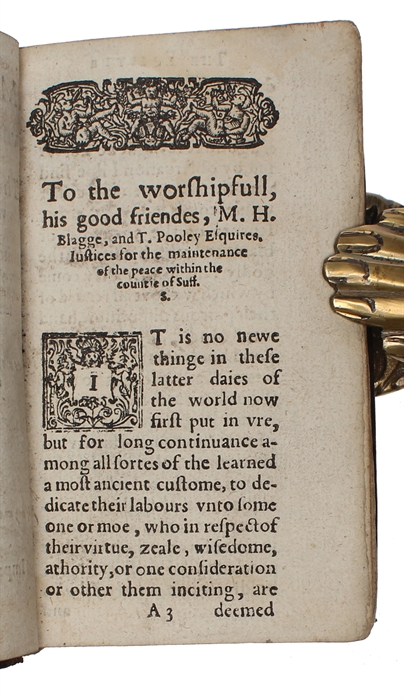A SOURCE FOR SHAKESPEARE'S "LOVE'S LABOUR'S LOST"
ROGERS, THOMAS (+) (ESTELLA, DIEGO DE).
A methode unto mortification: called heretofore, the contempt of the world, and the vanitie thereof Written at the first in the Spanish.
London, Iohn Windet, 1608.
12mo. In contemporary full calf. Small paper-label pasted on to top of spine. Wear to extremities, corners bumped. Edges of boards with loss of leather. Previous owner's names to front and back end paper ("Robert Wilson" & "Edvard Wilson, anno domini 1666"). Internally with a few light dampstains. (20), 328, 328-499, (4) pp.
The exceedingly rare second edition (the first being from 1586) of Roger’s somewhat free translation of ‘Papist’ Diego de Estalla’s work “Libro de la vanidad del mundo (Toledo, 1562). Roger’s admit that he had no access to the original but had to use the Itanlian and Spanish translations. "Love's Labour's Lost" is one of William Shakespeare's early comedies, believed to have been written in the mid-1590s. The play revolves around the King of Navarre and three of his noble companions who make a pact to swear off women and focus on scholarly pursuits for three years. However, their resolve is tested when the Princess of France and her entourage arrive on a diplomatic mission. Each of the men falls in love with one of the women, leading to a series of comedic misunderstandings, romantic entanglements, and wordplay. “It is also possible that some facts about the original author sparked Shakespeare’s interest. Diego de Estella was born in Navarre, and spent time the court of Philip II of Spain before incurring disapproval for his criticism of court life and being forced into a Franciscan monastery. Armado, the braggart and clown of Love’s Labour’s Lost, is the first Spaniard to appear in Shakespeare”. (Kingsley-Smith, A Method unto Mortification: A New Source for Love’s Labour’s Lost).
This present English translation, however, is of significant interest since recent research suggests it was a source and inspiration for Shakespeare’s ‘Love’s Labour’s Lost’:
At the opening of ‘Love’s Labour’s Lost’, the vow to renounce worldly pleasure has barely been announced before one of Navarre’s book-men declares his success: “Dumaine is mortified” (I.i.28). This ‘mortified’ is not a word Shakespeare would use often. It appears here in the sense of ‘having the appetites and passions in subjection’ and insensible or impervious to (the world and its pleasures), the latter informing Dumaine’s gloss: ‘To love, to wealth, to pomp. I pine and die’. The fact that this is the earliest use of ‘mortified’ in the Shakespearean canon is the first clue that one of the sources for Love’s Labour’s Lost was Thomas Roger’s A Methode unto Mortification, published in London in 1586 and again in 1608. Shakespeare’s pleasure in frustrating the ambitions of this book went some way to shaping his play”. (Kingsley-Smith, A Method unto Mortification: A New Source for Love’s Labour’s Lost).
Order-nr.: 60838



